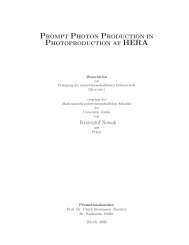Master Thesis Effect of vortex shaking on the ... - Physik-Institut
Master Thesis Effect of vortex shaking on the ... - Physik-Institut
Master Thesis Effect of vortex shaking on the ... - Physik-Institut
Create successful ePaper yourself
Turn your PDF publications into a flip-book with our unique Google optimized e-Paper software.
esult a real equilibrium. The measuring currents might in fact destroy <strong>the</strong><br />
effects <str<strong>on</strong>g>of</str<strong>on</strong>g> <strong>the</strong> <str<strong>on</strong>g>shaking</str<strong>on</strong>g> immediately. In order to prove this <strong>the</strong>sis, resistivity<br />
experiments should be made with crystals where <strong>the</strong> melting transiti<strong>on</strong> has<br />
already been found with magnetizati<strong>on</strong> measurements or similar methods,<br />
where <strong>the</strong> measurement itself does not destroy <strong>the</strong> equilibrium.<br />
4.2 LuNi 2 B 2 C<br />
In <strong>the</strong> beginning, <strong>the</strong> LuNi 2 B 2 C measurements showed <strong>the</strong> same unsatisfactory<br />
results as NdBCO, plus a peculiar temperature dependence seen in<br />
figure 14. For <strong>the</strong> effects <str<strong>on</strong>g>of</str<strong>on</strong>g> <str<strong>on</strong>g>shaking</str<strong>on</strong>g> <strong>the</strong> same arguments as before are again<br />
applicable, but <strong>the</strong> unexpected temperature dependence is even more difficult<br />
to explain. Later measurements (not described here) with <strong>the</strong> same<br />
setup, but again <strong>on</strong> <strong>the</strong> sec<strong>on</strong>d PPMS, did no l<strong>on</strong>ger show <strong>the</strong> “S” shaped<br />
curves that are caused by <strong>the</strong> <strong>on</strong>set <str<strong>on</strong>g>of</str<strong>on</strong>g> superc<strong>on</strong>ductivity and <strong>the</strong> quadratic<br />
slope as in <strong>the</strong> first measurements, <strong>the</strong> superc<strong>on</strong>ducting transiti<strong>on</strong> could not<br />
even be found any more. This leads me to believe that <strong>the</strong> crystal, or at least<br />
it surface, must have become n<strong>on</strong>-superc<strong>on</strong>ducting, most probably because<br />
<str<strong>on</strong>g>of</str<strong>on</strong>g> <strong>the</strong> silver epoxy c<strong>on</strong>tacts, which also may have caused <strong>the</strong> increase <str<strong>on</strong>g>of</str<strong>on</strong>g> <strong>the</strong><br />
resistivity with falling temperature.<br />
Now to <strong>the</strong> sec<strong>on</strong>d part <str<strong>on</strong>g>of</str<strong>on</strong>g> <strong>the</strong> LuNi 2 B 2 C experiment. Naturally it is <strong>the</strong><br />
topmost questi<strong>on</strong> why this feature arises and especially why it is an upward<br />
and not a downward peak as our <str<strong>on</strong>g>vortex</str<strong>on</strong>g> <str<strong>on</strong>g>shaking</str<strong>on</strong>g> <strong>the</strong>ory proposes. A sec<strong>on</strong>d<br />
questi<strong>on</strong> arises from <strong>the</strong> comparis<strong>on</strong> with <strong>the</strong> data from M. Reibelt. His<br />
peak in <strong>the</strong> specific heat for 2.5T is at ≈ 10.5K while <strong>the</strong> peak seen here is<br />
at 9.8K. This might just be due to different <strong>the</strong>rmometer calibrati<strong>on</strong>s, but a<br />
comparis<strong>on</strong> <str<strong>on</strong>g>of</str<strong>on</strong>g> ∆T, <strong>the</strong> difference between T c and <strong>the</strong> peak positi<strong>on</strong>, shows<br />
that his peak is quite closer to T c as our feature, ∆T (cp) ≈ 0 − 0.4K, where<br />
∆T (Ω) ≈ 1.2K. So we might in fact have found ano<strong>the</strong>r effect that is resp<strong>on</strong>sible<br />
for our feature. Let us return to <strong>the</strong> first questi<strong>on</strong>, which could be <strong>the</strong><br />
answer to this questi<strong>on</strong> as well. The fact that <strong>the</strong> feature is an increase in<br />
resistance instead <str<strong>on</strong>g>of</str<strong>on</strong>g> a drop and at a c<strong>on</strong>siderably lower temperature as <strong>the</strong><br />
suspected melting transiti<strong>on</strong> is probably an indicati<strong>on</strong> that <strong>the</strong> sample was<br />
still not in equilibrium state. But a well-founded explanati<strong>on</strong> for this effect<br />
can not be given without more experiments and more <strong>the</strong>oretical knowledge.<br />
It can <strong>on</strong>ly be stated here, that <strong>the</strong> magnetic history <str<strong>on</strong>g>of</str<strong>on</strong>g> <strong>the</strong> sample had in fact<br />
a c<strong>on</strong>siderable effect <strong>on</strong> <strong>the</strong> measured resistivity, which supports <strong>the</strong> findings<br />
<str<strong>on</strong>g>of</str<strong>on</strong>g> M. Reibelt.<br />
I’d like to thank Pr<str<strong>on</strong>g>of</str<strong>on</strong>g>. Schilling for <strong>the</strong> possibility to do this <strong>the</strong>sis and his<br />
supervisi<strong>on</strong>, and his group and o<strong>the</strong>r members <str<strong>on</strong>g>of</str<strong>on</strong>g> <strong>the</strong> institute for <strong>the</strong>ir kind<br />
help.<br />
28
















